Where to order takeout and delivery in Koreatown
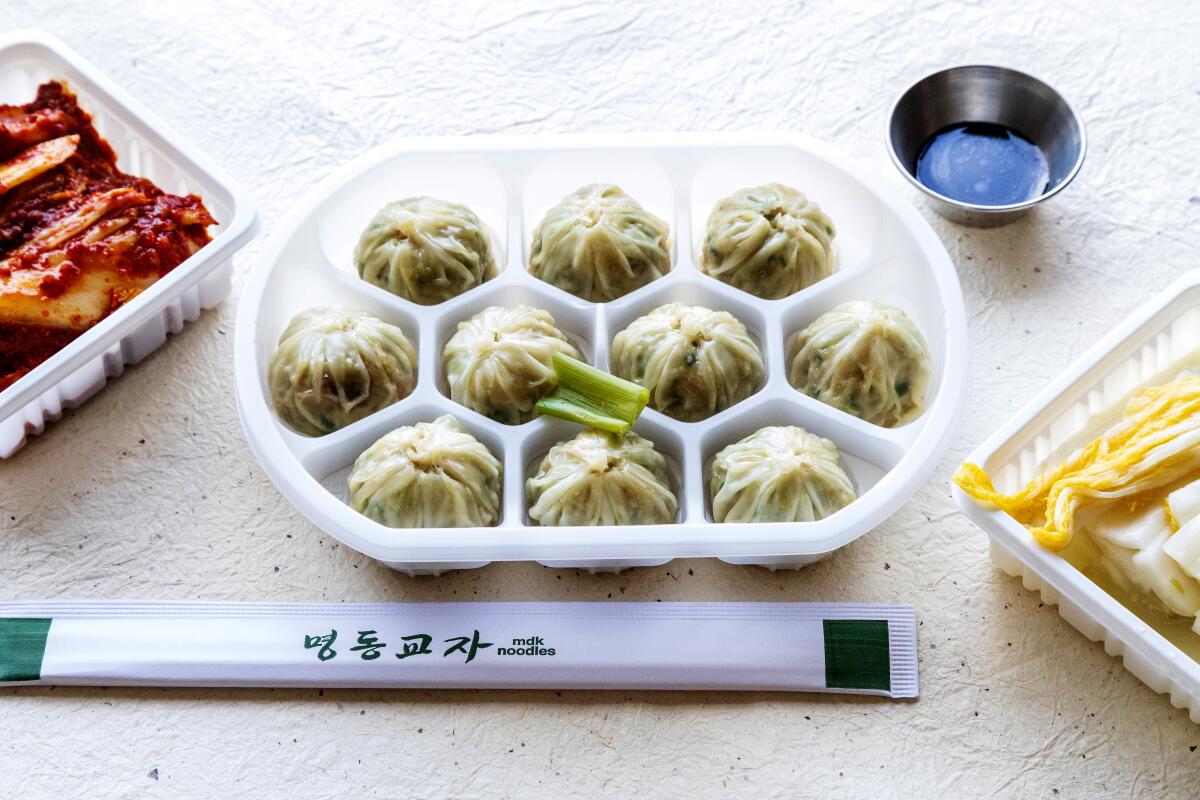
- Share via
America’s largest and most dynamic Koreatown is also one of Los Angeles’ fundamental dining neighborhoods. Even in a pandemic, with governmental rules about on-site dining in flux, the wealth of Korean cooking in the area remains as expansive as it does delicious. These are some favorites chosen by The Times’ Food staff.
Bonjuk

The description for the samgae chicken porridge on the menu at Bonjuk includes the following: “effective for the recovery of weariness and illness.” Although the porridge does contain Korean ginseng, there is no scientific evidence offered to back the claim. But when the world feels like it’s ending, this is the stuff we want to drown in. Porridge, normally a bland canvas, is fortifying on its own at Bonjuk. The cooking process stops before the kernels of rice lose their shape, giving the porridge a thick, hearty consistency. The samgae is crowded with bits of tender chicken, fragments of chopped carrot and diced green onion. There’s no need to accessorize, but the porridge comes with kimchi, a fresh chile sauce and a separate container of what tastes like chicken broth. Repeat spoonfuls of samgae until you feel better. Owner Catharine Park notes that the restaurant will most likely need to relocate in early January. Go while you can, and look out for a new location in the new year.
Bonjuk, 3551 Wilshire Blvd., Los Angeles, (213) 380-2248. Takeout and delivery.
Buil Sam Gye Tang
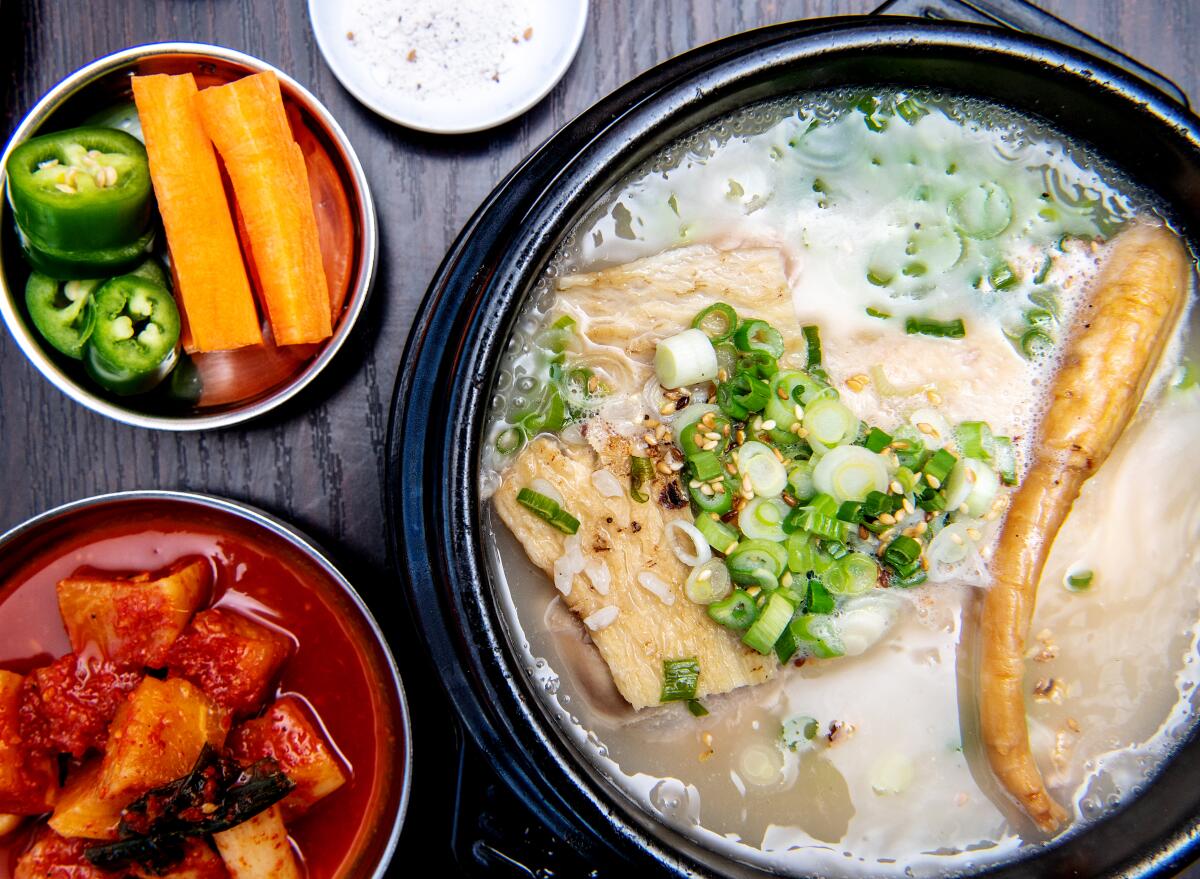
Chicken soup by nature is curative. At this juncture, we need chicken soup that is downright medicinal for the spirit (and also nourishing). Buil Sam Gye Tang specializes in such brothy remedies —young yang samgye tang includes a small, cut-up chicken in a gentle broth along with slices of fresh ginseng root with garlic, sweet potato, scallions, jujubes and other ingredients. Tip: Use the small takeout container of sea salt as a dip for bites of chicken. There are other variations of the soup that forego the ginseng, but its presence gives the soup a distinct, earthy sweetness.
Buil Sam Gye Tang, 859 S. Western Ave., Los Angeles, (213) 739-0001. Takeout only.
CHD Mandu
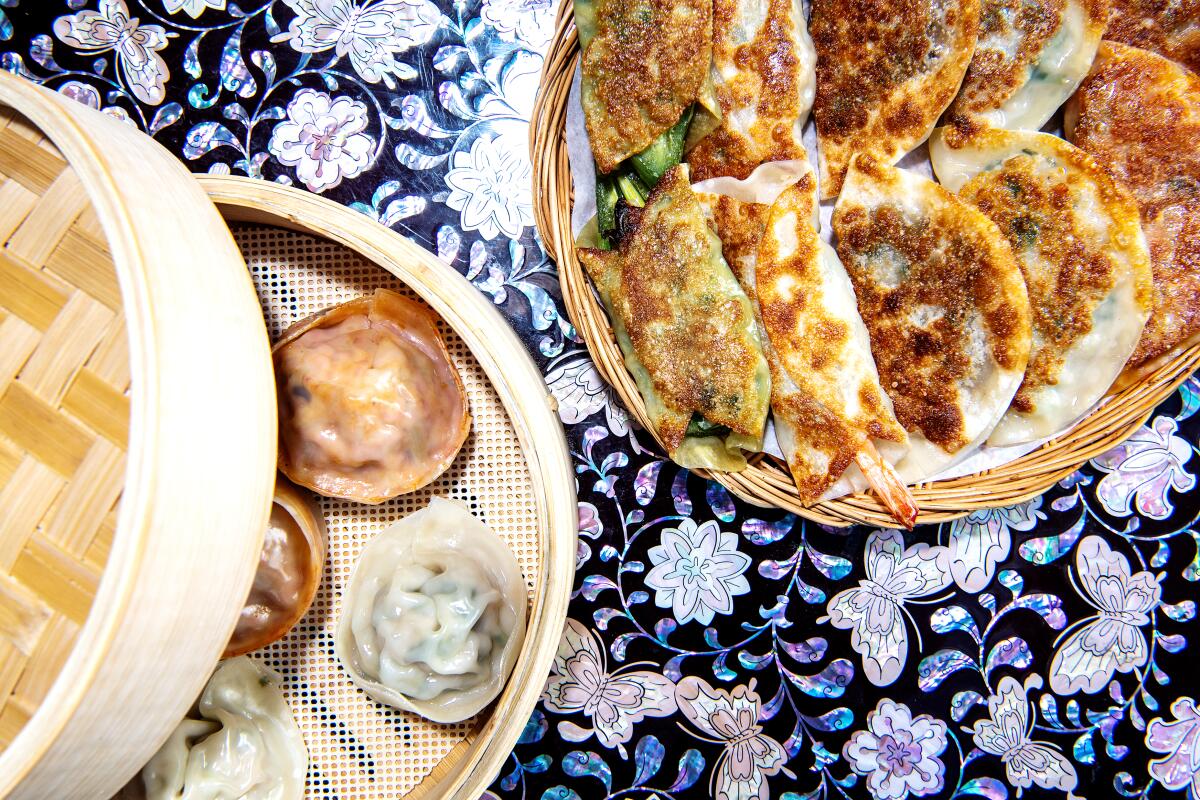
There’s no shortage of excellent dumplings in Koreatown. At Myung In, you’ll find softball-size baos filled with minced pork, mushrooms, glass noodles and scallions. The spicy steamed roll dumplings, with dumpling skins so thin they cling to the shrimp and pork filling like wet T-shirts, are also a favorite. But the mandu from CHD Mandu, an L.A. branch of the Korean franchise that opened earlier this year, are a specific breed of dumpling. And the mixed mandu plate is the best way to sample them all. The 10 dumplings are arranged neatly in pairs, all blistered, with two each of shrimp, kimchi, galbi, pork and chile mandu. The wrappers are delicate but sturdy, with a satisfying chew. Besides the chile and the shrimp, which come with their tails or stems peeking through, it’s impossible to tell which mandu are which. You’ll find the galbi dumplings plump with sweet meet, and the kimchi filled with minced cabbage. The pork filling is on the firmer side, reminiscent of a potsticker. Pretend it’s an assorted box of See’s candy and just dig in.
CHD Mandu, 3377 Wilshire Blvd., Los Angeles, (213) 334-4333. Takeout and delivery.
Myung In, 3109 W. Olympic Blvd., Suite B, Los Angeles, (213) 381-3568. Takeout and delivery.
Chunju Han-il Kwan

Budae jjigae, also known as Korean army stew (budae is the word for “army” or “troop,” and jjigae is the Korean word for “stew”), is a byproduct of the Korean War, a dish born out of war, made with rations such as Spam and baked beans brought in by U.S. troops. The one at Chunju Han-il Kwan lacks some of the “traditional” American ingredients, such as processed cheese and canned beans, but you’ll still find diced hot dog and Spam. It’s anything you could ever want in a pot, and a few items you might not have considered. If you order it “not cooked” (and we recommend it), the restaurant will provide two containers — one for the broth and another for the processed meats and raw diced carrot, zucchini, jalapeno, onion and green onion. And under all the meat and vegetables, there is plenty of tteok, rice cakes shaped like foam rollers. Throw it all in the pot with the prepared broth and simmer away until the tteok soften and the vegetables are tender. The soup base is a severe red color, but there’s just a hum of heat (nothing that will leave you sweating). If you own a portable butane gas burner, now is the time to use it — at the table. We prefer ladling spoonfuls into the bowl while the soup is still bubbling, without having to leave the table.
Chunju Han-il Kwan, 3450 W. 6th St., Los Angeles, (213) 480-1799. Takeout and delivery.
The Dragon

Open since 1940, the Dragon is a longtime Koreatown staple, serving Korean-influenced Chinese food in its large main dining area and multiple banquet rooms. Pre-coronavirus, you could find a bowl of jjajangmyeon on every table. The name is intentionally similar to the Chinese zhajiangmian, a dish made with noodles and fermented soybean. Jjajangmyeon involves chunjang, a sauce typically made from fermented soybeans, caramel and flour. At the Dragon, the noodles are packaged separately, waiting to be dressed. And the chunjang, an onyx-black sludge as shiny as a newly waxed sports car, is thick like a well-made gravy and studded with sliced onion and chunks of pork belly. It tastes of sweet onions and earthy black beans. At first, the slippery noodles seem to resist the gelatinous sauce, requiring some elbow grease to fully incorporate. But your hard work will be well rewarded. The sweet and sour pork, more sweet than sour, is also a favorite. .
The Dragon, 966 S. Vermont Ave., Los Angeles, (213) 387-8833. Takeout only.
Eighth Street Soondae

If you find yourself gravitating toward the unmistakable animal muskiness of black pudding, boudin noir, kaszanka and blutworst, then soondae is for you. And although you can find Korean blood sausage in many Koreatown plazas, the version at Eighth Street Soondae is superb. The obsidian sausages are plump with oxblood and dappled with translucent vermicelli packed in a paper-thin casing. The small soondae plate is adequate for four, accompanied by two types of chile sauce, a salty pickled radish condiment, kimchi, radish kimchi, hot broth and purple rice. The soondae is perfectly serviceable at room temperature, doused with chile, or left to wallow in the hot soup until stubs of sausage warm through. But you may prefer your soondae the next day, fried and seething, the casing shriveling and crisping around the edges. With a single order, you’ll have enough to eat it any way you like.
Eighth Street Soondae, 2703 W. 8th St., Los Angeles, (213) 487- 0038. Takeout only.
Ham Ji Park
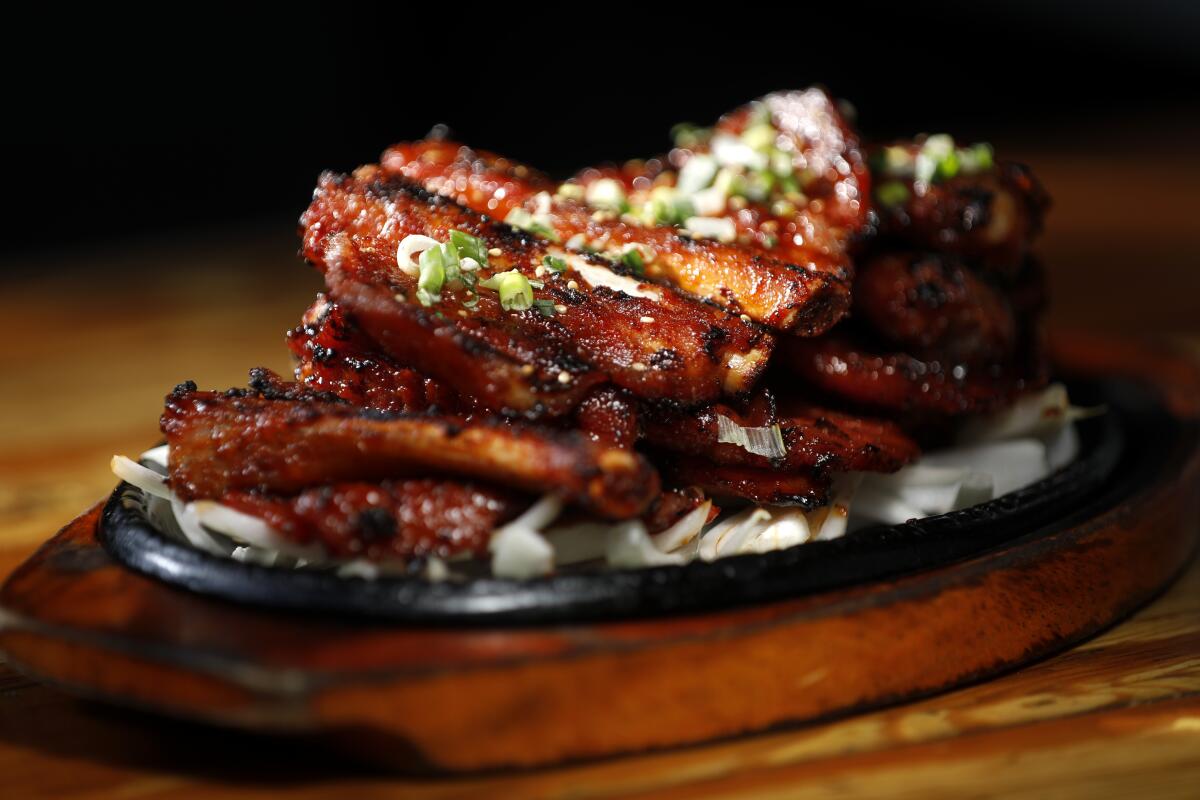
If you want something akin to the Ham Ji Park experience at home, heat the rust-red pork neck stew until it’s on the verge of hissing. Then bring it to the table and dig in before it cools, burning your tongue and the roof of your mouth — just a little. The soup smacks of pork and chile, with a rich viscosity that will cling to the bottom of the bowl. The stew will comfort you on many levels, but no Ham Ji Park order is complete without a heap of pork spare ribs. They are turned over the grill until they are well-charred and glistening. The fatty meat caramelizes along the edges, giving the ribs a sweet and salty flavor that echoes kalbi. The banchan is plentiful, even for takeout, with a selection of spicy cucumbers, two kinds of radish, bean sprouts, kimchi and salad. Takeout and delivery.
Ham Ji Park, 3407 W. 6th St., Los Angeles, (213) 365-8773. Takeout and delivery.
Hae Jang Chon

Before the pandemic, the restaurant’s barbecue commanded lines that spilled into the parking lot. It was easy to spend nights here with friends, slapping strips of pork belly onto the table grill, drinking too much soju and rolling out the door in a cloud of meat smoke. There’s no way to perfectly translate that just-kissed-the-grill flavor with takeout, but Hae Jang Chong gets pretty close. The paper-thin slices of meat are fragrant with sesame and soy, and cooked until just browned. They are packed tightly with slivers of white onion and mushrooms and served with white rice and pickled radish sauce. If you’re wondering about the banchan that typically accompany the barbecue, there’s a container full of sauteed fish cakes and green peppers, strands of pickled radish and steamed broccoli. And there’s kimchi, too. This restaurant offers pre-ordering on its website for pickup.
Hae Jang Chong, 3821 W. 6th St., Los Angeles, (213) 389-8777. Takeout and delivery.
Hanchic
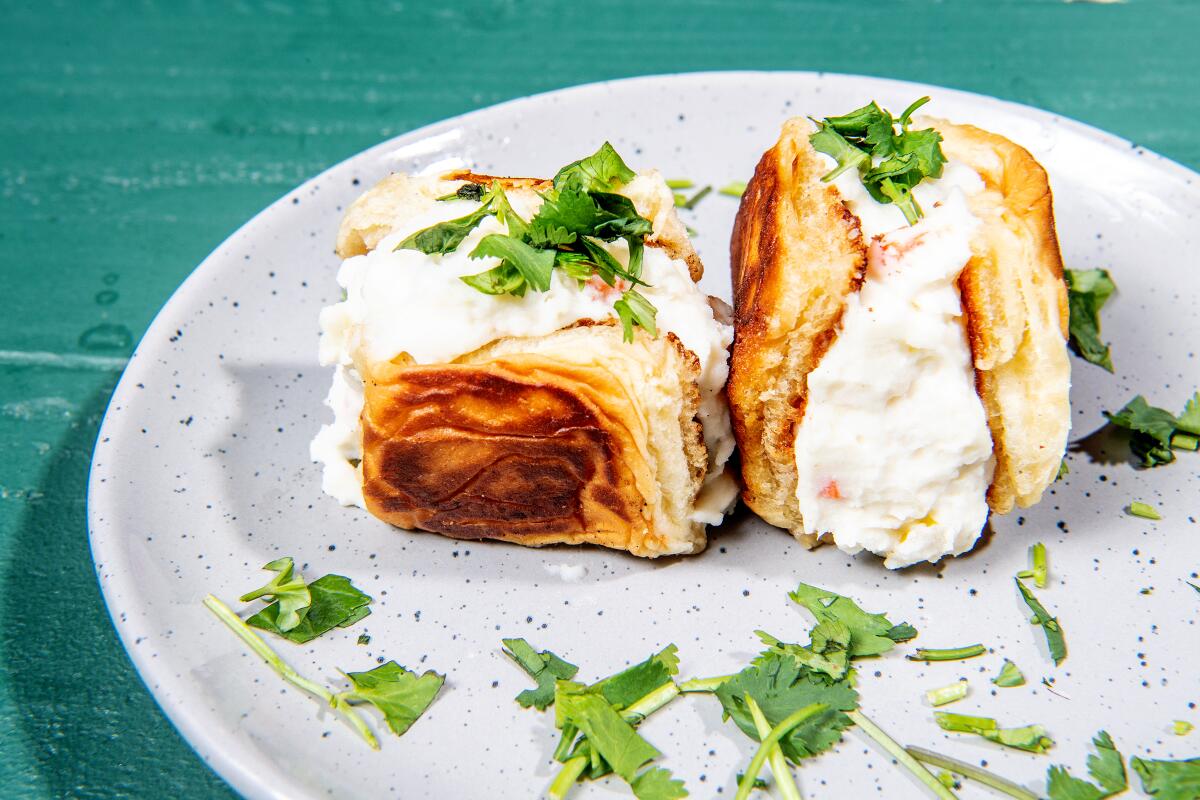
The food is decidedly fusion at Hanchic, Justin Min’s recently opened Korean restaurant in a strip mall on the eastern edge of Koreatown. Min, who spent years cooking at Little Sister, leans French and Italian with the menu but with a distinct Korean throughline. There’s the bouillabbong, a cross between a bouillabase and a spicy seafood noodle soup. And the kimchi tagliatelle, which features pasta tangled in a pork belly cream sauce with preserved lemon and kimchi. And a dish called “pork on crack,” which ended up being a luscious pork Bolognese on seasoned white rice. But the standout most comforting-during-quarantine dish ended up being something called a potato sammie. It’s exactly what it sounds like, only double: creamy, spreadable potato salad studded with pickled vegetables and sandwiched between two toasted, buttery Hawaiian rolls. The acid from the pickled carrot scythes beautifully through the layers of starches and carbs for an unassuming sandwich masterpiece.
Hanchic, 2500 W. 8th St., #103, Los Angeles, (213) 375-7095. Takeout and delivery.
Hangari Kalguksu

This restaurant makes some of the best knife-cut noodles, or any noodles for that matter, in town. When you order the spicy kalguksu to go, ask for the knife-cut noodles raw. (Hat tip to colleague Lucas Kwan Peterson for the tip.) The restaurant will happily give you a styrofoam cup of noodles dusted with flour, ready to cook to your desired doneness at home. If you don’t overdo it, the noodles will be chewy and springy when you submerge them in the hot broth, a spicy anchovy-suffused soup with a subtle heat. The restaurant is also doing a mini version of its famous bossam, packaged in no fewer than 10 cartons, each containing a different adornment for the pork. In one bowl, slivers of raw garlic and jalapeno; in another, pink disks of pickled radish. Layer them all onto a piece of cabbage with pork to create your ultimate bite. You can pre-order on the restaurant’s website.
Hangari Kalguksu, 3470 W. 6th St., Suites 9 and 10, Los Angeles, (213) 388-2326. Takeout and delivery.
Kobawoo House

For an at-home group feast, order the wang modum bossam — a haul of sliced pork, chile-flecked steamed skate and terrine-like slivers of glazed pork-feet meat, with vegetables and sauces for making wraps, and sides of purple or white rice. Kobawoo House makes a terrific haemul pajeon — the savory pancake stuffed with shrimp, mussels, crab, squid and scallions — but you might want to eat it in your car, sitting in the restaurant’s parking lot, before it steams and withers. The menu is fairly long, meandering through grilled meats, stir-fried squid, bibimbap and the homey doenjang jjigae, a spicy meat-free stew with umami-boosting soybean paste.
Kobawoo House, 698 S. Vermont Ave. #109, Los Angeles, (213) 389-7300. Takeout and delivery.
MDK Noodles
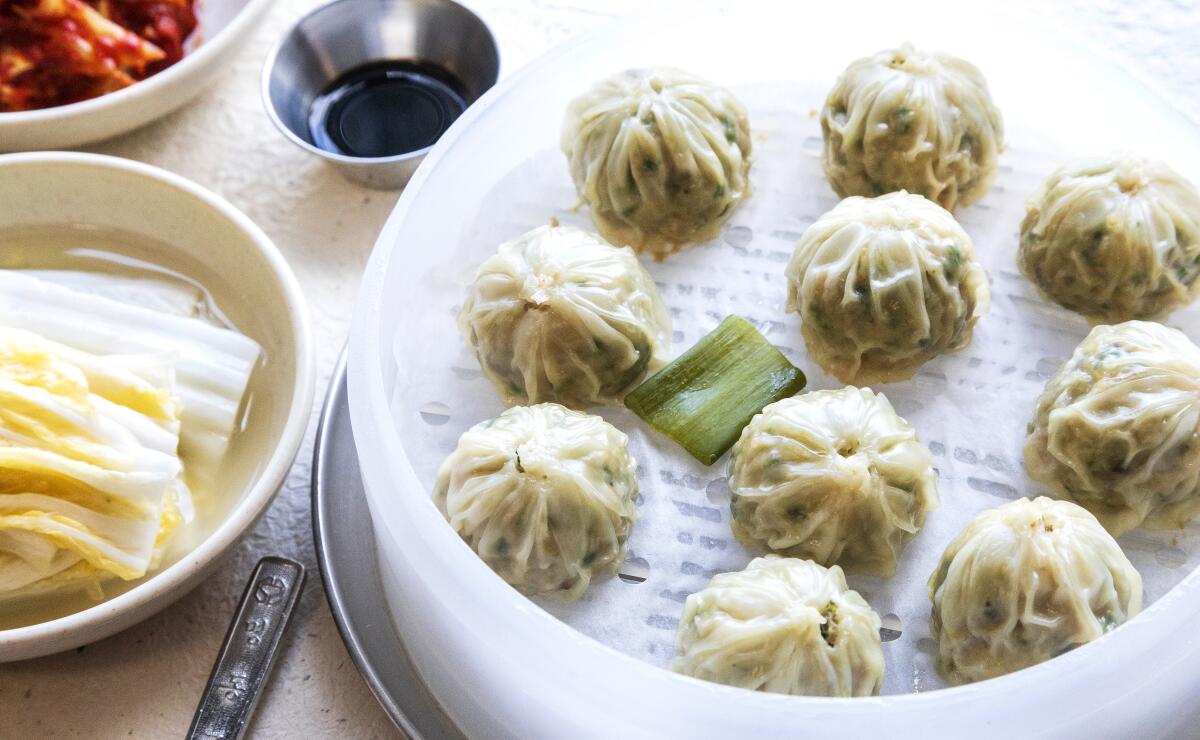
The patterns of the beautifully crinkled mandoo (dumplings) at MDK are as intricate as snowflakes, with the speckled green of the chives in the filling just peeking through the translucent wrapping. Choose between pork or pork with shrimp, or a pan-fried version in flattened rectangles. The kitchen seals the top of the mandoo takeout containers in plastic; peel it off and each dumpling remains distinct, not at all doughy. The vegetarian bibimbap, with equal hits of sweet chile sauce and sesame oil, has a welcome lightness. For warming comfort, try the soup of knife-cut noodles in spicy chicken broth.
MDK Noodles, 3630 Wilshire Blvd., Los Angeles, (213) 385-7789. Takeout and delivery.
Myungrang Hot Dog

If you spend any time on TikTok, you’re familiar with the Korean corn dog — it’s a mukbang favorite. Like its American counterpart, the hot dogs are coated in batter and fried on a stick. Unlike the American version, these dogs are encased in cheese, and are then battered and fried and rolled in sugar (if you want — and you want). You can also order battered cheese on a stick. Or you can add small fried potatoes to your batter for even more crunch. The plain dog with mozzarella cheese is a favorite; once you get past the crisp outer shell, the batter is chewier than what you’re used to, similar to the consistency of mochi. The squid ink dog, coated in a black squid-ink-infused batter, is rich and briny. Order one of the combos, called “sets,” to sample most of the menu. The dogs come with dipping sauces and flavored powders. Afterward, you may be dreaming of the “onion cream” powder, which tastes like sour cream and onion chip dust.
Myungrang Hot Dog, 450 S. Western Ave., Suite 313, Los Angeles, (213) 375-7518. Takeout and delivery.
Park’s BBQ
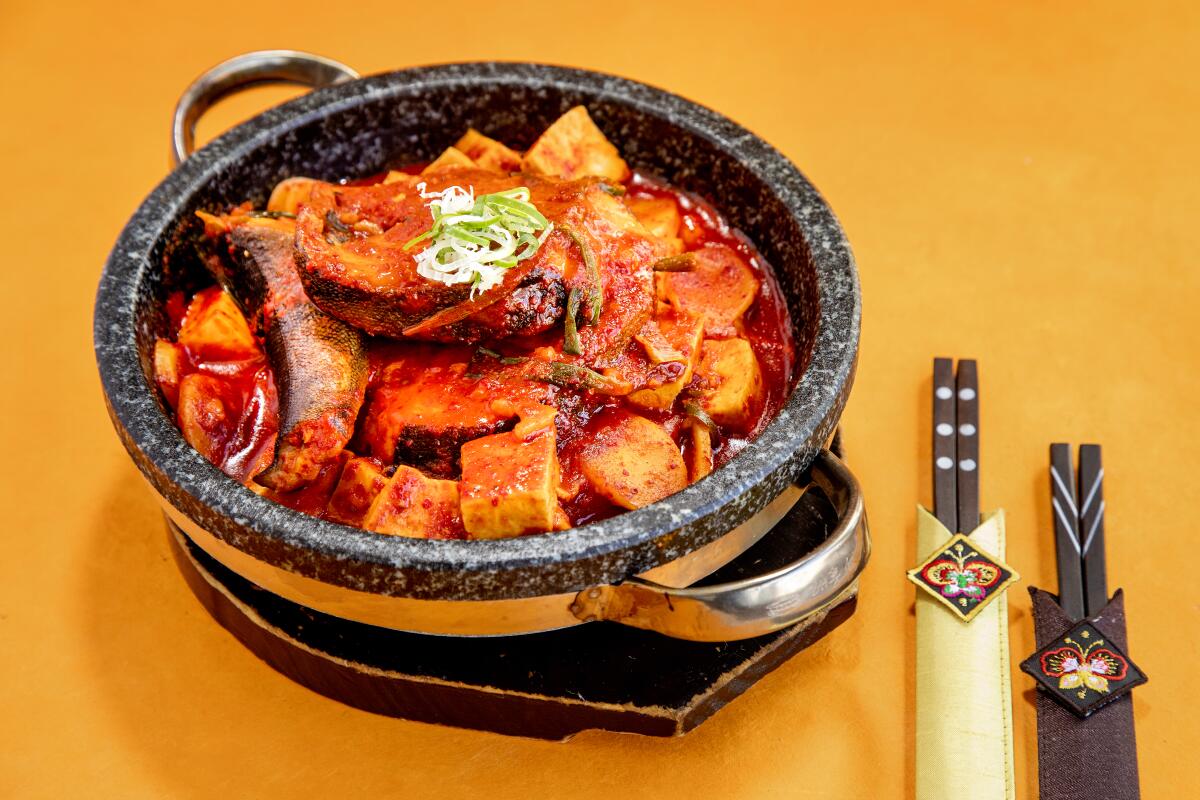
Jenee Kim runs the most acclaimed modern Korean barbecue restaurant in Los Angeles. Like so many other barbecue specialists, she had set up outdoor tables and open tents in the parking lot of the strip mall where Park’s resides; the scent of sizzling, richly marbled beef wafted down the block. With outdoor dining once again suspended, Kim rolls out a long menu for carryout: cooked, marinated galbi; short rib soup, with or without rice cakes; scarlet stews; and comforting japchae entangling beef and vegetables. The restaurant’s site also has an online shop for galbi, bulgogi, rib-eyes and other meats that are shipped for home grilling.
Park’s BBQ, 955 S. Vermont Ave., Los Angeles, (213) 380-1717. Takeout and delivery.
Soban
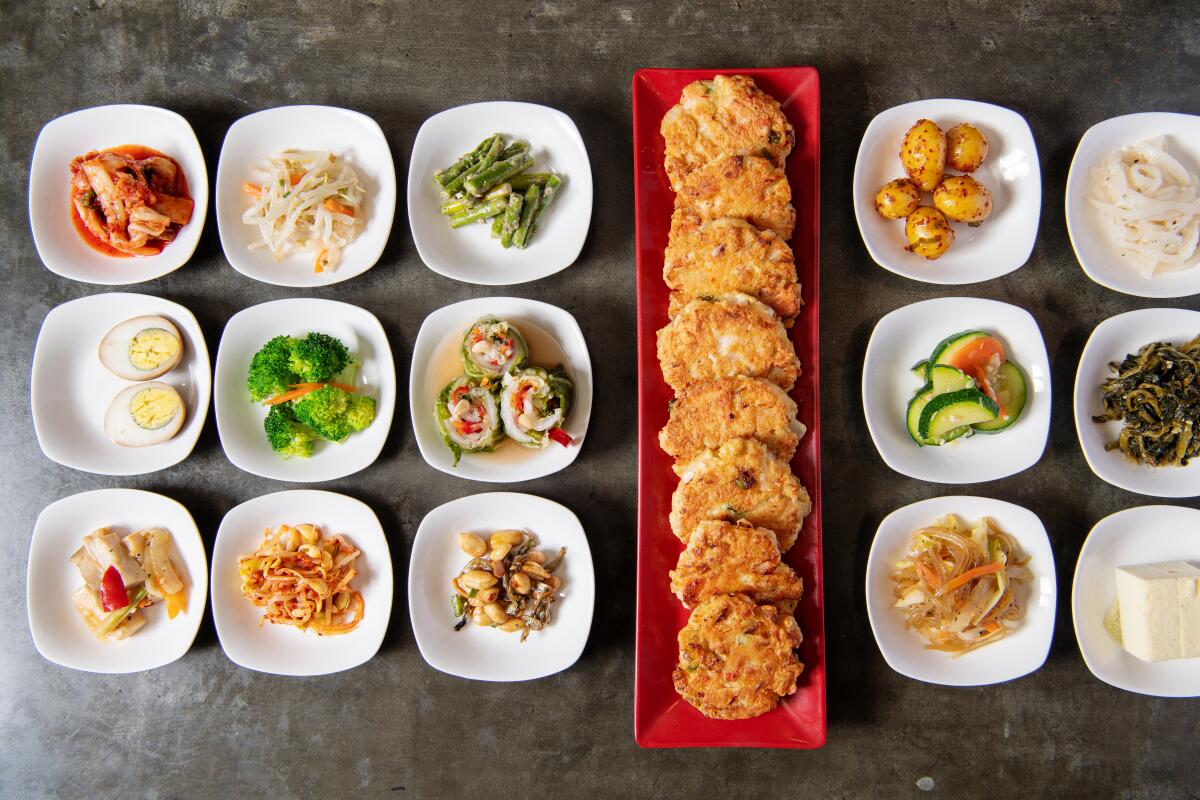
Is there one restaurant that acts as a gateway to the glories of Koreatown? It might well be Jennifer Pak’s Soban, where film director Bong Joon Ho and his team celebrated last February when “Parasite” became the first non-English-language movie in the history of the Academy Awards to win best picture. The lacy-edged haemul pajeon (seafood pancake); the spicy braised black cod seething in chile sauce with radish, squash, potatoes, and rice cakes; the famous raw crab steeped in an aromatic soy-based marinade; the pork bulgogi threaded with kimchi: all standard-bearers. The dishes, particularly braises and stews, hold up beautifully in takeout form, as does the always-excellent selection of banchan.
Soban, 4001 W. Olympic Blvd., Los Angeles, (323) 936-9106. Takeout and delivery.
Sun Ha Jang
Duck, duck, goodness. In non-pandemic times, the restaurant specializes solely in tabletop duck barbecue. The slices sizzle in a metal pan until the meat renders its fat, which glosses a finale of fried rice. The best part — the fried rice — is now one of two dishes Sun Ha Jang offers for takeout; the other is pan-roasted sliced duck with purple steamed rice. Both come with kimchi, pickles and a simple house salad for a complete, compact meal.
Sun Ha Jang, 4032 W. Olympic Blvd., Los Angeles, (323) 634-9292. Takeout only.
Witch’s Chicken
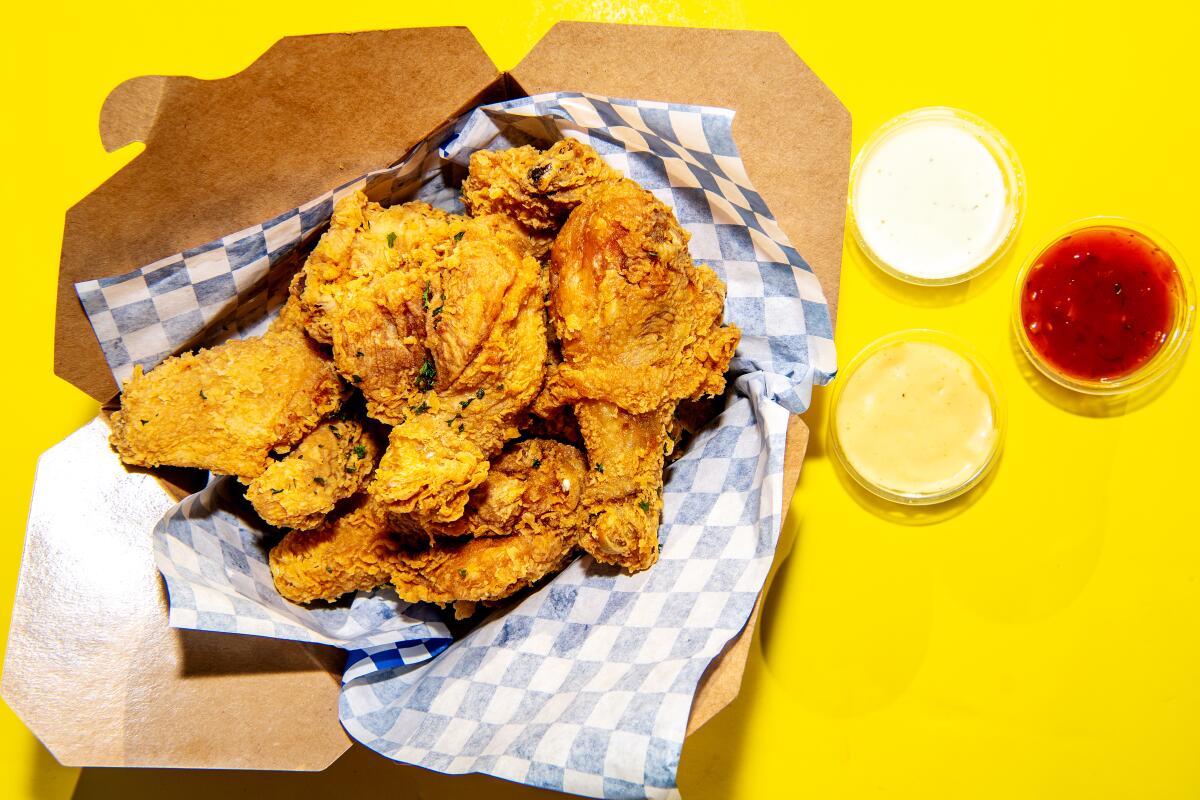
You can find yangnyeom dak, aka Korean fried chicken, on practically every commercial block in Chinatown, but Witch’s Chicken is a favorite that flies slightly under the radar. The stall is in the southwest corner of the lower-level market of the Koreatown Galleria. Chicken (as wings or a whole bird cut in pieces) is fried to order before being dipped in spice sauce (hot or mild) that glows a radioactive red-orange. The plain fried chicken drumsticks deliver plenty of crunch and pair well with dipping sauces, including chile sauce and a creamy number that brings to mind cilantro chutney. In an only-in-Los Angeles twist, the on-site menu also includes a radically enjoyable version of Peruvian pollo saltado that’s excellent for heating up later.
Witch’s Chicken, 3250 W. Olympic Blvd., Los Angeles. Takeout and limited delivery menu.
More to Read
Eat your way across L.A.
Get our weekly Tasting Notes newsletter for reviews, news and more.
You may occasionally receive promotional content from the Los Angeles Times.







